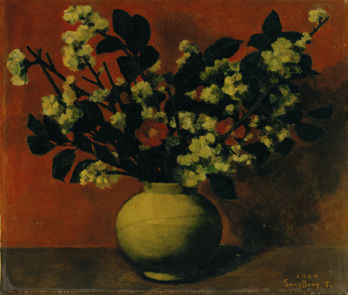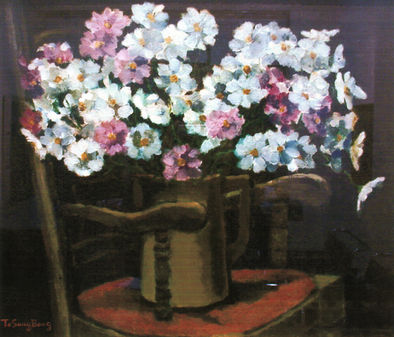Sangbong To
都相鳳 도상봉
Information
Sangbong To was a consistent oil painter with a committed attitude towards the objective strictness of his artistic ideas and realistic techniques. It is safe to argue that he embodied his own artistic weight and depth through such attitude. Korean modern and contemporary art history owes him greatly as a peculiar result of actualizing the traditional realism and the spirit of naturalism into his painting world with a steady production rate. His passion for his work began to appear prominently right after the 1953 truce. The paintings, including the “Ruins”, which painted the city of Seoul, which was destroyed by war, and the serene “Scenes of Sungkyunkwan” (Hoam Art Museum), which passed through the war, were painted in succession in the Seongbuk-dong studio of his after returning from the evacuation area of Busan.
On the surface of his interior works, in which he incorporated several white porcelain jars from the Chosun Dynasty, which the artist used to love with a high sense of taste, were frequently introduced, and stilled with lilies, chrysanthemums, lilacs, forsythia and other kinds of flowers and persisted until the 1970s. The most popular among the aficionados was the painting of white and purple lilac flowers in a white porcelain jar. However, the simple taste of such enthusiasts is virtually irrelevant to the strict assessment of the work itself. There are other materials, of course, that the typical works of Do display prominently in the still paintings of other types of flowers, fruits, or other everyday materials, and there are many works of fine art and masterpieces among the landscape paintings. Strict objective expressions and heavy-toned moods are typical of the "Sangbong To technique" of objects, all of which are characterized by rigorous and clear objective observations, uniquely deep and weighty tone, and a certain sense of stability in the composition.
도상봉은 자신의 예술 관념과 사실적 기법의 객관적 엄격성을 철저히 고수하는 태도로 일관한 유화가였다. 그 점에서 그는 스스로 각별한 예술적 무게와 깊이를 구현시켰다. 그는 꾸준한 제작생활로 전통적 사실주의와 자연주의 정신을 자신의 회화세계로 실현시킨 특질적인 대가로 우리의 근대·현대 미술사에 큰 빛을 남겼다. 그의 작품 열정이 두드러지게 표출되기 시작한 것은 1953년의 휴전 직후부터였다. 전쟁으로 파괴된 서울 일각을 침통하게 그린 <폐허>와 전쟁이 지나간 가을의 고요한 <성균관 풍경>(호암미술관)등 대작을 비롯하여 인물화 정물화가 피난지 釜山에서 돌아온 뒤에 성북동집 화실에서 잇따라 제작되었다.
그의 실내작품의 화면에는 작가가 높은 안목으로 애장(愛藏)하던 몇 개의 조선시대 백자항아리가 자주 도입되었고, 그 항아리에 백합·국화·라일락·개나리, 그밖에 수시로 선택한 여러 종류의 꽃이 꽂혀진 정물화가 1970년대까지 끊임없이 이어졌다. 그 중에서도 일반 애호가들 사이에서는 흰색과 보라색의 라일락꽃이 동그란 백자항아리에 꽃인 정물화가 가장 인기를 끌었다. 그러나 그러한 애호가들의 소박한 취향은 작품 자체의 엄정한 평가와는 사실상 관계가 없는 것이다. 다른 꽃이나 과일 또는 그 밖의 생활 주변 소재의 정물화에도상봉의 전형적인 작품성이 두드러지는 것이 많이 있고, 풍경화 중에도 물론 그런 가작(佳作) 수작(秀作) · 역작이 많음은 물론이다. 엄격한 객관적 표현과 무게 있는 색조 분위기작품들의 전형적인 "도상봉 수법"은 모두 대상의 엄격하고 명확한 객관적 관조(觀照)와 독특하게 깊이 있고 무게가 있는 색조 분위기, 그리고 구도의 확실한 안정감 등으로 특색을 성립시키는 세계이다.
Profile
1902 1월6일 함남 홍원 출생
1927 일본 동경미술학교 서양화과 졸업
개인전
2000 노화랑
1997 - 1998 한국근대미술: 유화 -근대를 보는 눈, 국립현대미술관
1994 송원갤러리
1987 10주기회고전 현대화랑
1975 현대화랑
1974 현대화랑
1972 현대화랑
1971 현대화랑
1970 현대화랑
1969 신세계화랑
1968 신세계화랑
1967 신세계화랑
1959 신세계화랑
1957 동화화랑
1955 초대전 월드하우스화랑 뉴욕
단체전
2006 예화랑 개관 28주년 특별기획전 예화랑
1997 - 1998 한국근대미술 :유화 -근대를보는눈 국립현대미술관
1995 한국현대미술전 뉴욕 월드하우스 뉴욕
1992 국립현대미술관 소장작가작품전 대구 강릉
1992 한국근대미술명품전 호암갤러리
1987 한국인물화전 호암갤러리
1986 한국현대미술의어제와오늘전 국립현대미술관
1985 한국양화70년전 호암갤러리
1985 현대미술40년전 국립현대미술관
1972 한국근대미술60년전 국립현대미술관
1941 - 1943 격조전창립동인전 일본 동경
수상
1960 3.1 문화상
1964 예술원상 예술원
1970 대한민국문화예술상
1970 대한민국 국민훈장모란장

